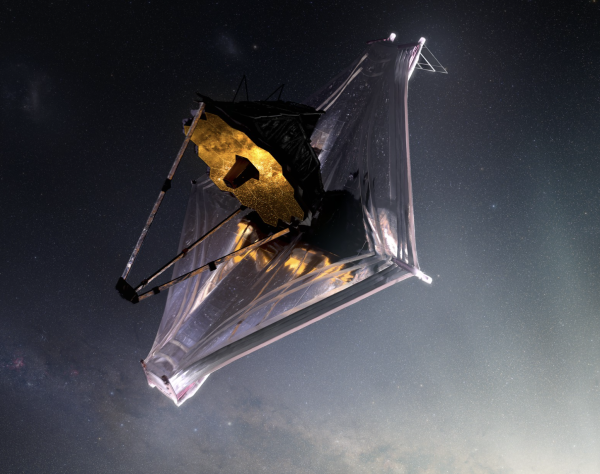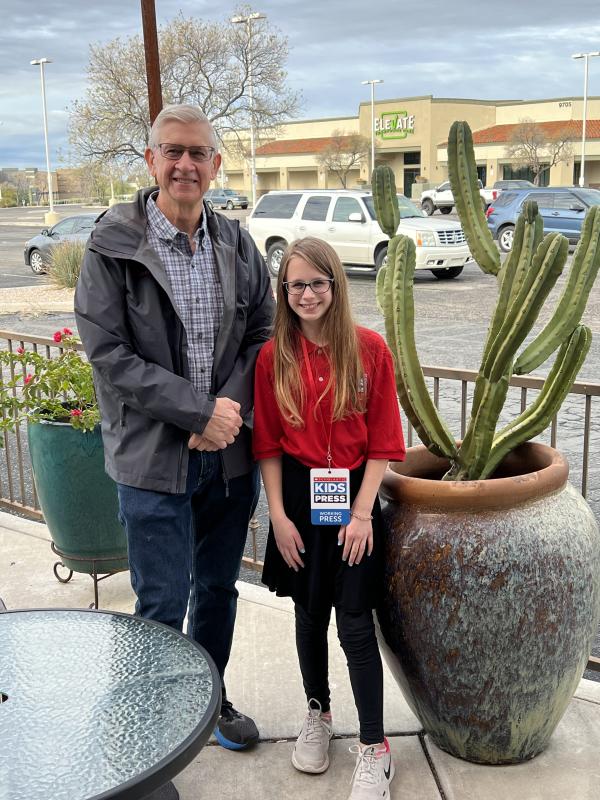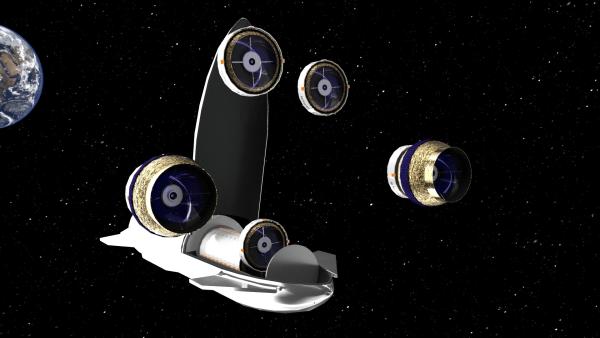KID REPORTERS’ NOTEBOOK
Project Nautilus Will Further Our Understanding of the Cosmos


An artist’s drawing of the James Webb Space Telescope, which was launched in 2021.
You’ve probably heard the lyrics to this popular lullaby: “Twinkle, twinkle little star, how I wonder what you are!” Thanks to Professor Tom Milster and other scientists, we’re learning more each day about the stars and outer space.
Milster teaches optical sciences and electrical and computer engineering at the University of Arizona in Tucson. I recently met with him to learn more about a new fleet of telescopes that he is helping to develop. The Project Nautilus telescopes will help expand our knowledge of faraway stars and planets.
Milster is an optical scientist, which means he studies light and optics to learn more about space. Like other astronomers, he is trying to determine if there is life on other planets.
Our atmosphere is made up of nitogen and oxygen. There are other gasses, too, including methane and water vapor. These gasses absorb different colors in the atmosphere, indicating that life is present. In order for a planet to sustain life, it has to give off the same colors as ours. A livable planet also has to be a certain size and in a habitable zone. It can’t be too close or distant from its star. That’s the case with Earth and its nearest star, the sun, which helps sustain life.
Astronomers can also use optical science to see if the universe is expanding. This is done by looking at the color shifts of the stars. If the color becomes more red, that means a star is moving away. If it becomes more blue, it’s coming closer to Earth.

Natalie learned about Project Nautilus from Professor Tom Milster, a scientist based at the University of Arizona.
HOW DO ASTRONOMERS USE TELESCOPES?
Astronomers want bigger and better telescopes so that they can gather more light from stars and planets that are farther away. The James Webb Space Telescope (JWST) is the most “complicated” telescope ever built. When the JWST was launched into space in 2021, its segments were folded up. All of the pieces had to open in space and line up perfectly.
“One of the things that made it so difficult,” Milster explained, “is that it’s not one big lens, but a bunch of smaller mirrors that have to work perfectly together to make images of galaxies and stars.”
The complex mission was a success. “Once that alignment happened,” Milster said, “we found out that the telescope works just as well as we thought it would. It was really an amazing piece of engineering and science to bring that all together.”
The JWST took 30 years and $10 billion to build. It is mirror-based. This makes it sensitive to misalignment, or the mirrors not lining up properly. Its mission lifetime is five years.

This computer-rendered image from Project Nautilus shows how identical telescope units could be deployed from Space X’s Starship rocket.
DEVELOPING THE NAUTILUS
Milster is helping to develop an ultra-lightweight lens for the new fleet of Project Nautilus telescopes that will eventually replace the JWST. For space telescopes, a lens is preferable to mirrors. For example, if you hold a mirror and move it just a little, the image in the mirror will move. A lens is used for eyeglasses. Even if you move, your glasses will keep everything in focus.
“Our telescope is based on a new, very thin lens that can be made very big,” Milster said. “It’s much lighter, so an array of telescopes can be launched into space with as few as three launches of a Space X Starship rocket.”
Developing the Nautilus will cost about the same as the JWST, Milster said, “but it will provide much greater capabilities to study exoplanet atmospheres.”
The hope is that the Nautilus will be able to explore 1,000 exoplanets (planets that orbit a star outside the solar system) from star systems up to 1,000 light years away. In order to see this far, you need a telescope that is 50 meters (about 164 feet) in diameter. A group of 30 separate Nautilus telescopes will be able to do this. By comparison, the largest telescope that can be launched today is only 10 meters (about 33 feet) in diameter.
“The targeted science mission for the Nautilus is to examine the atmospheres of exoplanets for signs of life,” Milster said. He is eager to learn more. “I really like the research,” he said, “and doing things nobody else has done.”
